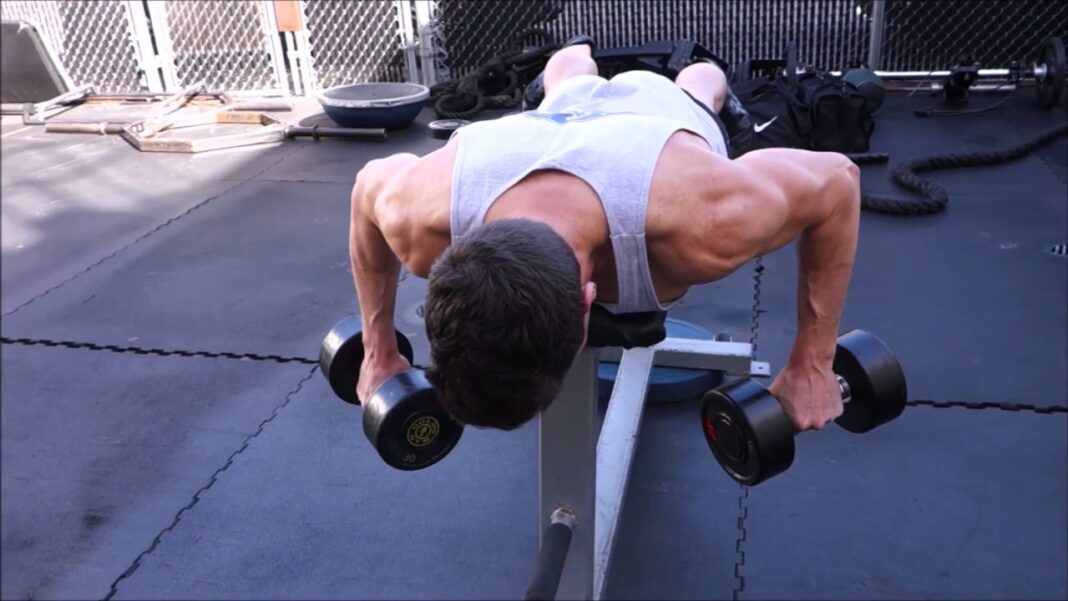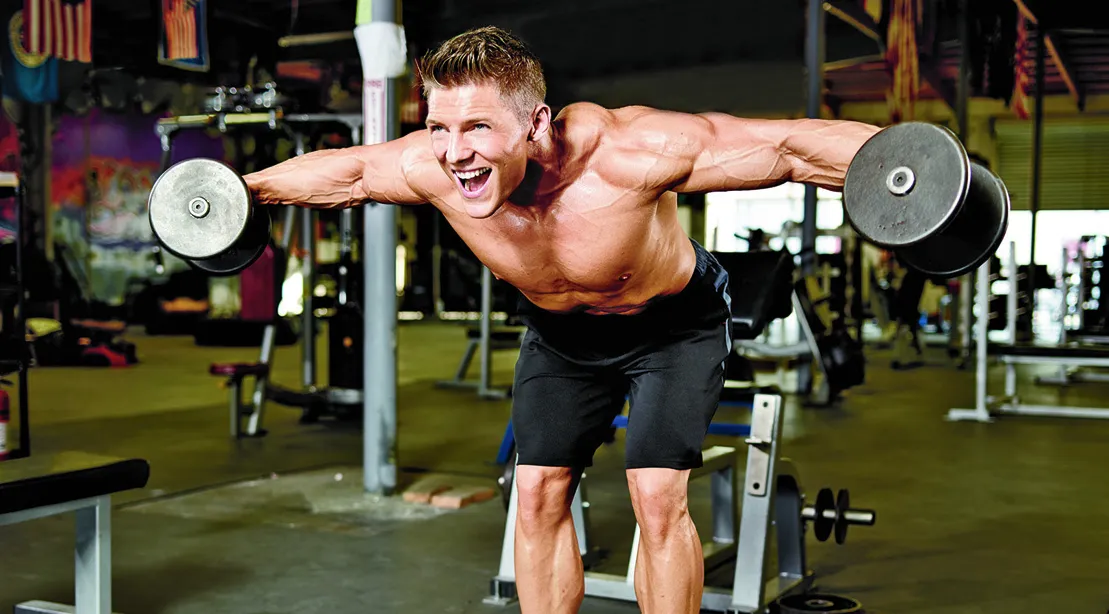Rear Delt Dumbbell Workouts: Free Weight Precision for Maximum Size
When lifters talk about building wide, round shoulders, most of the attention goes to front presses and lateral raises. But here’s the truth: if you want that 3D look, the kind of shoulders that pop from every angle on stage or at the gym, you can’t afford to skip rear delt training.
Rear delts (posterior deltoids) are notoriously underdeveloped because they don’t get much direct work in pressing or pulling compounds. They’re also harder to feel and isolate than front or side delts. That’s where dumbbells shine.
Sure, cables and machines offer constant tension, but dumbbells remain the backbone of serious rear delt development.
They build raw strength, allow natural freedom of movement, and carry over into your big compounds like rows, pull-ups, and presses.
As a bodybuilder, I’ve always kept dumbbell variations in my programming. They’re versatile, scalable, and brutally effective if you execute them with precision. In this guide, I’ll break down:
- Why dumbbells are essential for rear delt training.
- The best dumbbell rear delt exercises and how to perform them.
- Sample workouts for mass, strength, and home training.
- Programming strategies to maximize growth.
- Practical takeaways for lifters at every level.
Why Dumbbells Are Essential for Rear Delt Training
Freedom of Movement
Machines lock you into a path, which is great for isolation but not always ideal for individual shoulder mechanics. With dumbbells, you can customize the range and angle to fit your structure, reducing joint strain while improving activation.
Stabilizer Engagement
Dumbbells force your stabilizers to work harder. This builds overall shoulder health, joint integrity, and athletic carryover. Strong stabilizers protect you when you’re pressing heavy or hitting big rows.
Progressive Overload
Adding weight in small increments is easy with dumbbells. Rear delts respond well to gradual progression, especially when paired with high-rep sets and strict form.
Carryover to Compounds
Stronger rear delts make you more stable on the bench press, improve lockout strength in overhead pressing, and support scapular control in pull-ups and rows. They’re not just an aesthetic muscle—they’re a performance booster.
Bottom line: Dumbbells give you versatility, overload potential, and functional strength that cables and machines can’t fully replicate.
The Best Dumbbell Rear Delt Exercises
Here are the staples every lifter should know, plus some bodybuilding favorites to really torch the posterior delts.
Bent-Over Rear Delt Fly
- Setup: Hold dumbbells with a neutral grip. Hinge at the hips with a flat back and slight bend in the knees.
- Execution: Raise arms out to the sides in an arc, leading with the elbows. Stop just above shoulder height.
- Cue: Avoid shrugging—keep traps relaxed.
- Rep Range: 12–15.
Why it works: It’s simple, direct, and brutally effective. Perfect for building the mind-muscle connection with your rear delts.
Incline Rear Delt Fly (Chest-Supported)
- Setup: Lie chest-down on an incline bench set at 30–45 degrees, dumbbells hanging straight down.
- Execution: Fly arms outwards, elbows slightly bent.
- Cue: Slow, controlled motion. Don’t jerk the weight up.
- Rep Range: 15–20.
Why it works: The bench eliminates momentum, forcing pure rear delt isolation. This is a bodybuilding staple for carving detail.
Dumbbell Reverse Row (Elbows Flared)
- Setup: Hinge forward, dumbbells hanging with palms facing in.
- Execution: Row up with elbows flared wide (not tucked like a lat row).
- Cue: Think about driving elbows outward, not backward.
- Rep Range: 8–12.
Why it works: A hybrid between a row and a fly, this lets you load the rear delts heavier than fly variations. Great for strength and size.
Seated Lean-Forward Rear Delt Raise
- Setup: Sit on the edge of a bench, torso leaned forward with dumbbells under legs.
- Execution: Fly arms out in a wide arc.
- Cue: Keep chest down to avoid cheating with momentum.
- Rep Range: 12–15.
Why it works: Controlled seated position ensures tension stays where you want it—on the rear delts.
Dumbbell “Power Partials” (Heavy Cheat Raises)
- Setup: Grab heavy dumbbells, hinge slightly forward.
- Execution: Perform half-range raises with a slight body swing.
- Cue: Use controlled “cheat” form but don’t turn it into a shrug.
- Rep Range: 20–30 partials.
Why it works: Overloads the rear delts with volume and mechanical tension. This old-school finisher has been a secret weapon for bodybuilders chasing size.
Sample Rear Delt Dumbbell Workouts
Here are plug-and-play sessions you can use depending on your goal and equipment.
Mass-Building Dumbbell Session
- Incline Rear Delt Fly – 4×15–20
- Dumbbell Reverse Row – 3×8–10
- Bent-Over Rear Delt Fly – 3×12–15
- Power Partials – 2×20–25
Why it works: Combines strict isolation with heavier loading and a brutal high-volume finisher for hypertrophy.
Strength/Accessory Day
- Seated Rear Delt Raise – 4×12
- Dumbbell Reverse Row – 4×8
- Incline Rear Delt Fly – 3×15
Why it works: Focuses on strength-oriented lifts while still reinforcing stability and control. Perfect as an accessory block after pressing or pulling.
Home Training (Minimal Equipment)
- Bent-Over Rear Delt Fly – 4×15
- Dumbbell Reverse Row – 3×12
- Power Partials – 2×20+
Why it works: No bench or machines required. Great for home gyms or travel setups.
Programming Notes for Rear Delt Training
- Train 2–3x per week
Rear delts recover quickly, so they benefit from higher frequency. - Balance rep ranges
Use lighter loads and higher reps (12–20) for fly variations, and moderate loads (8–12) for rows. - Prioritize strict form
Rear delts are small muscles. Swinging or shrugging takes tension away and wastes reps. - Finish with pump work
Partials, burnouts, or drop sets add metabolic stress, which complements mechanical tension. - Don’t skip progression
Even in isolation lifts, progressive overload matters. Add reps, weight, or sets gradually over time.
Training Strategies for Different Levels
Beginners
- Stick to two variations (like bent-over fly + reverse row).
- Focus on form, time under tension, and mind-muscle connection.
- Start with 6–8 weekly sets.
Intermediate Lifters
- Rotate between 3–4 movements weekly.
- Mix strict isolation (flies) with heavier rows.
- Target 10–12 weekly sets across 2–3 sessions.
Advanced Bodybuilders
- Use specialization phases if rear delts lag.
- Add rear delt work early in sessions, not just as a finisher.
- Experiment with intensity techniques like giant sets, partials, and tempo manipulation.
- 12–15+ weekly sets, spread across multiple sessions.
Practical Takeaways
- Dumbbells = freedom and overload. They’re adaptable to any setup, from a commercial gym to a garage.
- Combine strict and heavy work. Pair chest-supported flies with heavy reverse rows or partials for well-rounded growth.
- High frequency is key. Rear delts need consistent, direct attention to grow.
- Best tool for home gyms. Dumbbells alone can build big, round rear delts if you apply progression and variety.
- For complete shoulders, combine tools. Dumbbells give raw strength and natural range; cables and machines add constant tension. Together, they create a full-spectrum program.
Conclusion
Rear delts aren’t just an afterthought—they’re a defining muscle for anyone chasing a wide, round, and balanced physique. If your shoulders look flat from the side, it’s time to start training them like a priority.
While cables and machines have their place, dumbbells remain the foundation of rear delt development.
They give you freedom of movement, functional strength, and the ability to progressively overload without relying on fixed equipment.
From strict incline flies to heavy power partials, dumbbell variations offer a perfect mix of precision and overload.
Program them 2–3 times per week, push for progression, and combine strict isolation with strategic heavy work.
Do this consistently, and your rear delts won’t just catch up—they’ll stand out, completing your shoulders and giving you that true 3D look every bodybuilder wants.





